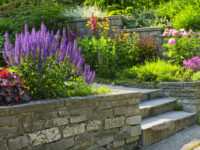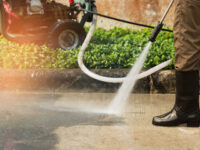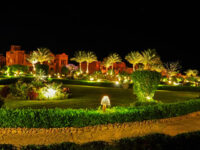Landscaping Basics
Landscaping adds value to your property and makes for a more enjoyable outdoor space. It also provides healthy and clean air through the use of a variety of plants, birds, insects and other wildlife.
Lines can influence the character of a landscape – straight lines create structure and formality while curves evoke relaxation or a natural ambience. Texture refers to the variety of visual details that distinguish different parts of a garden. Visit Website to learn more.
Plant selection is an important part of the overall landscape design process. It includes consideration of the aesthetic you would like to achieve, as well as practical elements such as water and sunlight requirements. Taking time to choose appropriate plants for your environment is the best way to ensure the long-term health and beauty of your garden.
The starting point for plant selection is to identify all of the areas in your garden that you want to use. This can include seating areas, pathways, water features and other focal points. Then, make a list of the environmental factors that will impact those areas, such as sun exposure, soil type and pH, microclimates, deer resistance or salt tolerance, and more.
Next, think about how those areas will be used in the future. For example, do you plan to grow vegetables in one area? Do you want to create a privacy hedge in another? Or maybe you want to grow tall grasses that can be walked through without being cut back. It is important to remember that these landscape plants will continue to grow, so you should keep their mature size in mind.
A good rule of thumb is to select trees and shrubs that are native to your area or at least well adapted to the local climate and soil conditions. They will be better suited to your environment and can help reduce the need for irrigation, pest control and other maintenance. They can also support local wildlife and be more drought-tolerant.
When selecting plants, it is also important to consider the color, shape and texture of the foliage. Choosing a variety of shapes, colors and textures will add visual interest to the landscape throughout all seasons. Also, consider whether you want deciduous or evergreen landscape plants. Deciduous plants lose their leaves in the winter while evergreens maintain their form year-round.
Don’t be afraid to try new plants! While it may seem tempting to stick with those that have been recommended by others, there are often many new varieties on the market that can provide stronger benefits for your garden. For example, there are now many plants that are both low-allergenic and drought-tolerant. Additionally, there are a growing number of plant innovations that offer more colorful blooms and improved durability.
Design
When creating a landscape, it’s important to consider how you will use the space. For example, if you plan to entertain guests, you may want to include a dining area or fire pit. Similarly, if you have children, you might prefer a lawn that can be used for games. Taking these considerations into account will help you choose the right plants and create a functional, appealing garden.
While gardening is focused on the care and cultivation of individual plants, landscaping goes beyond that to incorporate larger-scale design elements like water features and outdoor structures. It also involves modifying the terrain of an outdoor space by adding or removing soil and altering the surface shape of the ground through grading and mounding. This can improve drainage and usability, and it’s often necessary for projects like erosion control or improved privacy.
Choosing the right colors is another key element of landscaping. Using the color wheel to guide your choices can help you narrow down the possibilities and find a palette that complements your home’s exterior and creates a balanced and cohesive look. For example, warm colors like reds and yellows add excitement and pop, while cool colors like blues and purples blend into the background and evoke serenity.
Other design considerations include focal points, which can be used to draw attention and create contrast. For example, a boldly colored flower or unique tree can make an excellent focal point. Using different textures can also add interest to your landscape. A combination of both hardscape and softscape can also be effective, with the hardscape components including walkways, paving, and outdoor structures, while the softscape includes trees, shrubs, and flowers.
One common mistake that people make when creating a garden is not taking into account the maintenance requirements of their chosen plants. This can lead to costly mistakes down the line, as certain plants require more upkeep than others. It’s also important to consider the climate and soil type when selecting plants, as these factors can affect the health and appearance of your landscape.
Another important consideration is ensuring that your landscape is wildlife-friendly. If you have local wildlife that frequents your property, you’ll want to ensure that you’re not choosing plants that they will be drawn to, which can cause damage or even attract unwanted guests like pests and disease.
Maintenance
When designing your landscape, it is important to consider maintenance. Depending on the types of plants you select and how much sun or shade they get, they may require different amounts of water and attention. It is also necessary to take into account the climate of your area, as this can affect watering schedules, soil type, and pests that you might encounter.
The most common mistake people make when planning a landscaping project is choosing low-maintenance plants but not taking into account how they will be used or maintained. While this may seem like a good way to reduce expenses and save time, it can end up costing you more in the long run. If you choose a plant that requires more care than you can provide, it will eventually become unhealthy and unattractive. On the other hand, if you plan your landscape with maintenance in mind, you can create an outdoor space that is both beautiful and functional.
To avoid making costly mistakes when designing your landscape, it is best to consult a professional. Not only will they be able to advise you on the best plants for your location, but they can help you budget for installation and ongoing care. They can also assist with creating a watering and maintenance schedule to ensure that your plants stay healthy and vibrant.
Landscaping includes both softscaping and hardscaping, which refers to the use of plants, soil, rocks, mulch, wood, bricks, and water features like ponds and fountains. Softscaping is primarily concerned with the arrangement of plants, while hardscaping is more focused on design elements that create a more organized and structured outdoor space.
While landscaping is primarily about the aesthetics of an outdoor space, it can also add to the value of your property and enhance functionality. Landscaping can also be done to address a specific problem, such as erosion, drainage, or privacy.
While it is a great idea to keep up with seasonal landscape maintenance, it can be time-consuming and difficult for homeowners to do on their own. The key is to be proactive with maintenance, which means regularly inspecting and performing basic tasks, such as removing leaves from paved areas and picking up debris after mowing. Regular watering, fertilization, and weed control are also essential to keeping your yard looking its best.
Irrigation
Irrigation is an important part of any garden, farm, or commercial plant production operation. It allows growers to control the timing and amount of water applied to crops, helping ensure consistent yields and healthy plant growth, especially in regions where natural rainfall is insufficient or unpredictable.
Irrigation also helps reduce waste and maximizes the effectiveness of fertilizers by ensuring that all plants get an adequate supply of water when they need it. A professional irrigation system is designed to match the specific needs of each landscape, incorporating soil type, weather patterns, and plant species.
A well-designed and installed irrigation system can help prevent erosion by distributing water evenly across the property. This reduces the chance of washout or runoff, which can damage soil health and lead to nutrient depletion. Regular maintenance on the system can also ensure that sprinklers are delivering water at an even rate, preventing excessive or insufficient coverage that could damage or over-water plants.
Landscaping adds beauty and value to a home or business while providing a functional outdoor space for entertaining, relaxing, or working. Properly planned and executed landscaping projects can increase property value, improve air quality, and enhance the visual appeal of a building or surrounding area.
Irrigation is an essential part of any garden, farm, or commercial landscape and can help reduce waste and maximize the effectiveness of fertilizers by ensuring that plants get an adequate supply of water when they require it. A professional irrigation system is designed to meet the specific needs of each landscape, incorporating factors such as soil type, weather patterns, and plant species. A well-designed and installed irrigation system can also help prevent erosion by distributing water evenly across property, reducing the chance of washout or runoff, and maintaining an optimal soil moisture level. A professional irrigation system can also help prevent over or under-watering by distributing water based on soil conditions, reducing the risk of disease and promoting plant health. Water features can add beauty and interest to a garden or outdoor space by creating movement, sound, and reflection. They can include ponds, streams, waterfalls, and other water fixtures, or they can be simple, organic features like stone pathways or decorative mulch.






